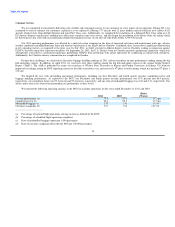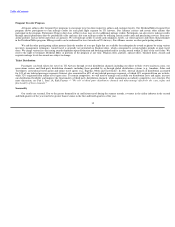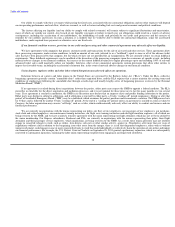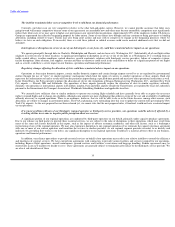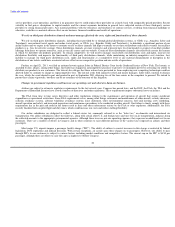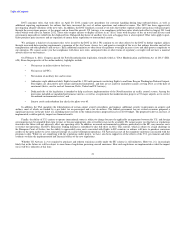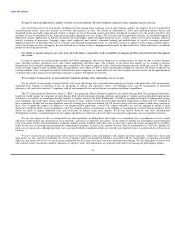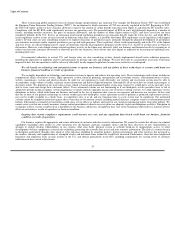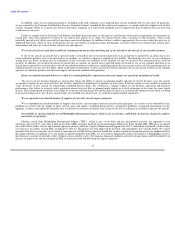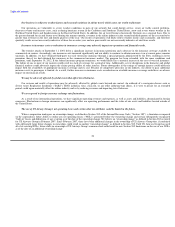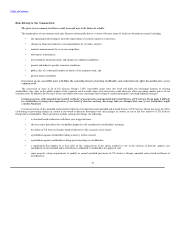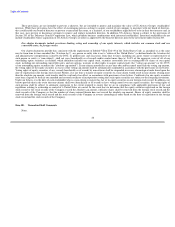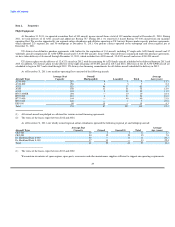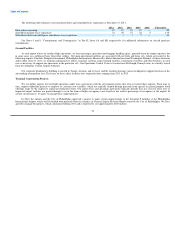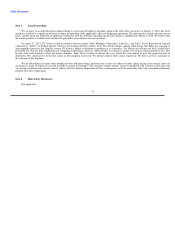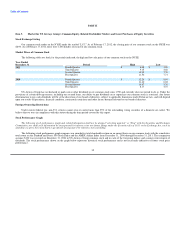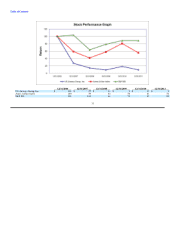US Airways 2011 Annual Report Download - page 27
Download and view the complete annual report
Please find page 27 of the 2011 US Airways annual report below. You can navigate through the pages in the report by either clicking on the pages listed below, or by using the keyword search tool below to find specific information within the annual report.
Table of Contents
There is increasing global regulatory focus on climate change and greenhouse gas emissions. For example, the European Union ("EU") has established
the European Union Emissions Trading Scheme ("ETS"), the mechanism by which emissions of CO2 are currently regulated in the EU. Beginning in 2012,
the ETS will require airlines to have emission allowances equal to the amount of carbon dioxide emissions from flights to and from the EU member states.
Compliance with the EU ETS could significantly increase our operating costs. The potential impact of ETS on costs will ultimately depend on a number of
factors, including baseline emissions, the price of emission allowances, and the number of future flights subject to ETS, and these costs have not been
completely defined. In the U.S., there is an increasing trend toward regulating greenhouse gas emissions directly under the Clean Air Act, and while EPA's
recent regulatory activity in this area has focused on industries other than aviation, it is possible that future EPA regulations or new legislation could impact
airlines. Several states are also considering initiatives to regulate emissions of greenhouse gases, primarily through the planned development of greenhouse
gas emissions inventories and/or regional greenhouse gas cap and trade programs. These regulatory efforts, both internationally and in the U.S. at the federal
and state levels, are still developing and we cannot yet determine what the final regulatory programs will be in the U.S., the EU or in other areas in which we
do business. However, such climate change-related regulatory activity in the future may adversely affect our business and financial results by requiring us to
reduce our emissions, purchase allowances or otherwise pay for our emissions. Such activity may also impact us indirectly by increasing our operating costs,
including fuel costs.
Governmental authorities in several U.S. and foreign cities are also considering or have already implemented aircraft noise reduction programs,
including the imposition of nighttime curfews and limitations on daytime take-offs and landings. We have been able to accommodate local noise restrictions
imposed to date, but our operations could be adversely affected if locally-imposed regulations become more restrictive or widespread.
We rely heavily on technology and automated systems to operate our business, and any failure of these technologies or systems could harm our
business, financial condition or results of operations.
We are highly dependent on technology and automated systems to operate and achieve low operating costs. These technologies and systems include our
computerized airline reservation system, flight operations system, financial planning, management and accounting systems, telecommunications systems,
website, maintenance systems and check-in kiosks. In order for our operations to work efficiently, our website and reservation system must be able to
accommodate a high volume of traffic, maintain secure information and deliver flight information. Substantially all of our tickets are issued to passengers as
electronic tickets. We depend on our reservation system, which is hosted and maintained under a long-term contract by a third-party service provider, to be
able to issue, track and accept these electronic tickets. If our automated systems are not functioning or if our third-party service providers were to fail to
adequately provide technical support, system maintenance or timely software upgrades for any one of our key existing systems, we could experience service
disruptions or delays, which could harm our business and result in the loss of important data, increase our expenses and decrease our revenues. In the event
that one or more of our primary technology or systems vendors goes into bankruptcy, ceases operations or fails to perform as promised, replacement services
may not be readily available on a timely basis, at competitive rates or at all, and any transition time to a new system may be significant. Our automated
systems cannot be completely protected against other events that are beyond our control, including natural disasters, computer viruses or telecommunications
failures. Substantial or sustained system failures could cause service delays or failures and result in our customers purchasing tickets from other airlines. We
cannot assure you that our security measures, change control procedures or disaster recovery plans are adequate to prevent disruptions or delays. Disruption in
or changes to these systems could result in a disruption to our business and the loss of important data. Any of the foregoing could result in a material adverse
effect on our business, results of operations or financial condition.
Ongoing data security compliance requirements could increase our costs, and any significant data breach could harm our business, financial
condition or results of operations.
Our business requires the appropriate and secure utilization of customer and other sensitive information. We cannot be certain that advances in criminal
capabilities (including cyber attacks or cyber intrusions over the Internet, malware, computer viruses and the like), discovery of new vulnerabilities or
attempts to exploit existing vulnerabilities in our systems, other data thefts, physical system or network break-ins or inappropriate access, or other
developments will not compromise or breach the technology protecting the networks that access and store sensitive information. The risk of a security breach
or disruption, particularly through cyber attack or cyber intrusion, including by computer hackers, foreign governments and cyber terrorists, has increased as
the number, intensity and sophistication of attempted attacks and intrusions from around the world have increased. Furthermore, there has been heightened
legislative and regulatory focus on data security in the U.S. and abroad (particularly in the EU), including requirements for varying levels of customer
notification in the event of a data breach.
24


